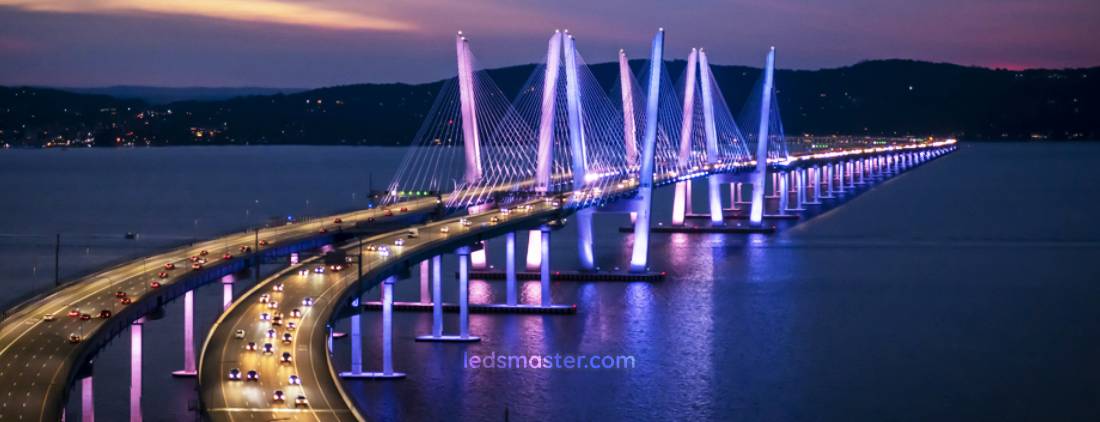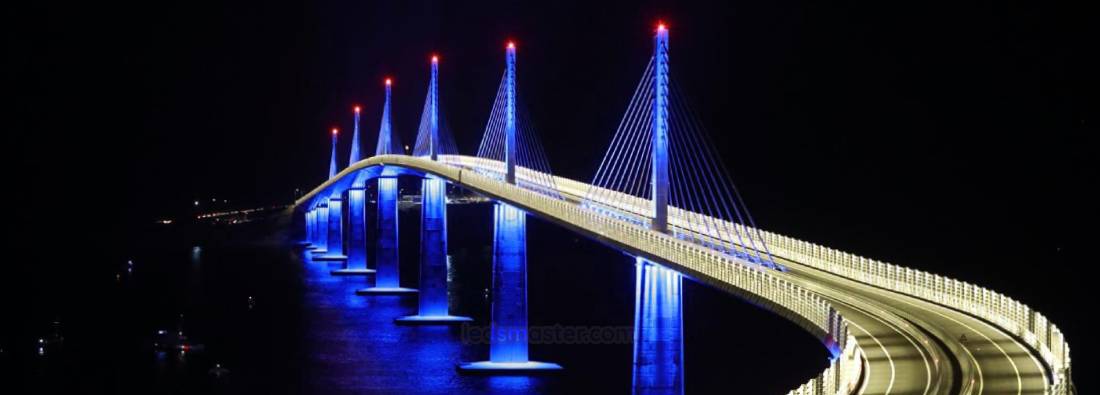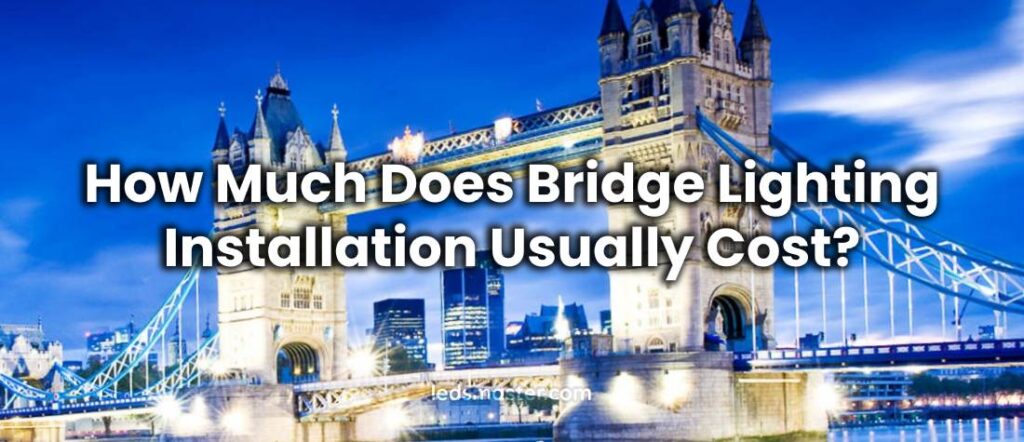Table of Contents
ToggleLamp Cost
Types of Lamps for Bridge Lighting
| Category | Details | Cost Range ($) |
|---|---|---|
| Lamp Costs | ||
| Incandescent Lamps | Affordable upfront, short lifespan | 10 – 20 per unit |
| LED Lamps | Energy-efficient, long-lasting | 50 – 200 per unit |
| Durable Materials (e.g., Stainless Steel, Aluminum) | Weather-resistant, long-lasting | 100 – 300 per unit |
| Custom/Ornate Designs | Enhanced aesthetics, custom-made | 500 – 1,000+ per unit |
| Bulk Purchasing Discounts | Reduced per-unit cost | Up to 20-30% off |
| Labor Costs | ||
| Electricians/Contractors | Region and expertise-dependent | 30 – 100 per hour |
| Installation Labor | Based on 200-400 man-hours | 6,000 – 40,000 total |
| Equipment Rental | Cranes, cherry pickers, etc. | 500 – 2,000 per day |
| Maintenance Costs | ||
| LED Systems Maintenance | Minimal upkeep | 2,000 – 5,000 annually |
| Traditional Lighting Maintenance | Frequent repairs and replacements | 5,000 – 10,000 annually |
| Environmental Cleaning | Cleaning due to harsh weather | 1,000 – 3,000 annually |
| Additional Costs | ||
| Accelerated Timelines | Shorter schedules increase labor needs | 20-30% higher labor costs |
| Transportation to Remote Areas | Delivery logistics | 5 – 20 per unit |
The choice of lamp significantly impacts the total cost of a bridge lighting project. Traditional incandescent lamps are generally the most affordable, with prices ranging from $10 to $20 per unit. However, these lamps have shorter lifespans, often requiring replacement every 1,000 to 2,000 hours, leading to higher long-term expenses.
In contrast, LED lighting systems are more expensive upfront, with costs typically ranging from $50 to $200 per unit, depending on the wattage, brightness, and design. Despite the higher initial investment, LEDs are favored for their energy efficiency and durability. With lifespans of 25,000 to 50,000 hours and energy savings of up to 75% compared to traditional lamps, LED systems offer substantial long-term cost benefits. The decision between these options often depends on the project’s budget and objectives.

Material and Design of Lamps
The materials used in lamp construction influence their durability and price. Lamps made from stainless steel or corrosion-resistant aluminum are priced between $100 and $300 per unit, offering longevity and reduced maintenance needs in harsh environmental conditions. These materials are often selected for outdoor and bridge lighting projects where exposure to weather elements is a concern.
Design complexity also affects cost. Standard, simple lamp designs are more budget-friendly, with prices starting at $50 per unit. Custom-made or ornate designs, often used for landmark bridges, can range from $500 to $1,000 per unit or more, reflecting the specialized craftsmanship and additional materials required.
Procurement and Quantity
The price of lamps can vary based on the procurement method and the volume purchased. Bulk purchasing often reduces the per-unit cost, with discounts of up to 20-30% for large orders. For example, a bulk order of 500 LED lamps priced at $150 each could result in savings of $15,000 to $22,500 through volume discounts.
Additional costs such as shipping fees, import duties, and storage must also be considered. For projects in remote areas, transportation costs may add $5 to $20 per unit, depending on the distance and logistical challenges. Sourcing materials locally can mitigate these expenses and streamline delivery timelines.
Labor Cost
Installation Labor
Labor costs for bridge lighting installations vary widely based on project complexity and location. In urban areas, electricians and contractors may charge $50 to $100 per hour, while rates in rural regions can range from $30 to $70 per hour. Installing a standard lighting system on a medium-sized bridge may require 200 to 400 man-hours, translating to labor costs of $6,000 to $40,000, depending on the region and workforce.
Some projects necessitate the use of specialized equipment, such as cranes or cherry pickers, which can cost $500 to $2,000 per day to rent. The need for such equipment can increase overall labor expenses, particularly for tall or hard-to-access bridges.
Maintenance and Repairs
Ongoing maintenance is another factor to consider. LED lighting systems, due to their durability, generally require less frequent upkeep, costing around $2,000 to $5,000 per year for a medium-sized bridge. In comparison, traditional lighting systems may incur maintenance expenses of $5,000 to $10,000 annually, driven by frequent bulb replacements and repairs.
Environmental conditions such as heavy rainfall, snow, or dust can necessitate additional cleaning or repairs, which may cost an extra $1,000 to $3,000 annually. Establishing a maintenance schedule and working with experienced professionals can help manage these costs effectively.
Project Timeline
The timeline of the project also influences labor costs. Projects completed within shorter timeframes often require additional manpower or extended work hours, increasing expenses. For example, expediting a bridge lighting project by hiring more electricians or scheduling night shifts might add 20-30% to labor costs. A project initially estimated at $20,000 could escalate to $24,000 to $26,000 under such circumstances.
Conversely, planning the project with a realistic timeline allows for efficient allocation of resources and can reduce labor costs. Seasonal considerations, such as avoiding installation during extreme weather, can further optimize timelines and expenses.
By carefully evaluating these factors, project planners can make informed decisions that balance cost efficiency with quality and performance in bridge lighting installations.

Factors Affecting the Installation Cost
Bridge Dimensions and Structure
The overall size and architectural design of the bridge significantly impact the installation costs for lighting systems. Larger bridges typically require more lighting fixtures, wiring, and other materials, increasing the overall budget. Additionally, the scale of the structure may necessitate the use of specialized equipment, such as cranes or scaffolding, to install lighting fixtures effectively.
Unique architectural designs or irregular shapes can further complicate the installation process. Bridges with curves, intricate patterns, or decorative elements often demand custom lighting solutions to ensure an even and visually appealing distribution of light. Customizations like these can increase both material and labor expenses, as they often involve additional design and engineering work.
Accessibility and Location
The location of a bridge can greatly influence the total cost of installation. Bridges situated in remote or hard-to-access areas typically involve higher transportation expenses for delivering equipment, materials, and personnel to the site. Logistics challenges can also arise if the bridge is located in a densely populated urban area with limited access points, requiring careful planning to minimize disruptions to traffic and nearby communities.
Inaccessible or restricted pathways may necessitate the use of specialized tools or machinery, such as aerial lifts or boats, depending on the surroundings. These requirements can add to both time and expenses, making location and accessibility key factors in project planning.
Power Supply and Infrastructure
A reliable power supply is a fundamental requirement for any bridge lighting system. If an adequate power source is unavailable near the bridge, the project may incur additional expenses for establishing a connection. These costs could include extending power lines, installing transformers, or integrating backup systems for uninterrupted power.
In cases where connecting to the main power grid is not feasible, alternative solutions such as solar-powered systems might be considered. While solar systems reduce dependency on external power sources and operational costs over time, they can involve a higher initial investment, including the cost of solar panels, batteries, and associated components.
Environmental and Safety Considerations
Environmental and safety regulations can add complexity and cost to bridge lighting installations. For bridges located in ecologically sensitive areas, installation methods and materials may need to comply with strict environmental guidelines to minimize disruption to local ecosystems. For example, lighting systems designed to reduce light pollution and wildlife disturbance may be required.
Safety is another critical factor during installation. Projects must adhere to strict safety standards to protect workers and road users, often requiring the use of protective equipment, specialized training for personnel, and compliance with local or national regulations. These measures can add to the overall expense, but they ensure a safe and legally compliant installation process.
How to Minimize the Cost
Opt for Energy-Efficient Lamps
Choosing energy-efficient lighting systems, such as LED lamps, can significantly reduce long-term costs. LEDs consume less power than traditional lighting options, leading to lower energy bills. Additionally, their extended lifespan minimizes replacement frequency, reducing maintenance expenses over time. While the upfront cost of LEDs may be higher, the overall savings they provide make them a practical choice for many bridge lighting projects.
Choose Standardized Designs
Using standardized lamp designs and fixtures can help reduce expenses by avoiding the need for custom fabrication. Many manufacturers offer a variety of pre-designed options tailored for outdoor or bridge lighting applications. Opting for these readily available products not only saves on production costs but also simplifies the installation process, as standardized components are often easier to integrate and maintain.
Plan Efficiently
Proper planning is one of the most effective ways to control installation costs. A detailed assessment of the bridge’s lighting requirements can help determine the optimal placement and quantity of fixtures, avoiding unnecessary expenses. Collaborating with experienced contractors and suppliers can ensure accurate cost estimates and streamline the project timeline. Scheduling work during non-peak hours or using phased installation strategies can also help manage labor expenses more effectively.
Leverage Government Grants or Subsidies
Financial support from government programs, grants, or subsidies can significantly reduce the overall cost of bridge lighting projects. Many governments and organizations encourage infrastructure improvements and energy efficiency initiatives, offering funding or incentives to offset project expenses. Exploring these options during the planning phase can provide valuable financial relief.
Regular Maintenance
A proactive maintenance schedule can prevent costly repairs or replacements in the future. Regularly cleaning fixtures, inspecting electrical components, and addressing minor issues promptly can extend the lifespan of the lighting system and ensure consistent performance. Investing in durable materials and weather-resistant designs further reduces the likelihood of damage, lowering maintenance-related costs over the long term.
Utilize Local Resources
Sourcing materials and labor locally can be a cost-effective approach, as it reduces transportation expenses and supports the regional economy. Local suppliers are often more accessible and may offer competitive pricing, as well as quicker delivery times for materials or replacement parts. Utilizing nearby resources can streamline project logistics and contribute to overall savings.
Careful planning, strategic decision-making, and resource optimization allow for effective management of costs while achieving durable and visually appealing bridge lighting installations.
Conclusion
Effective management of costs for bridge lighting installation requires careful consideration of lamp types, labor expenses, and the factors influencing project complexity. By selecting energy-efficient systems, planning efficiently, and exploring cost-saving measures such as standardized designs and local resources, it is possible to achieve durable and visually appealing lighting solutions while optimizing expenses. Regular maintenance and thoughtful project execution further ensure long-term performance and value.

